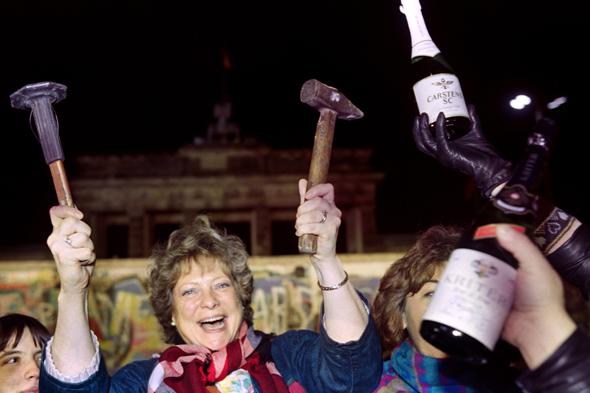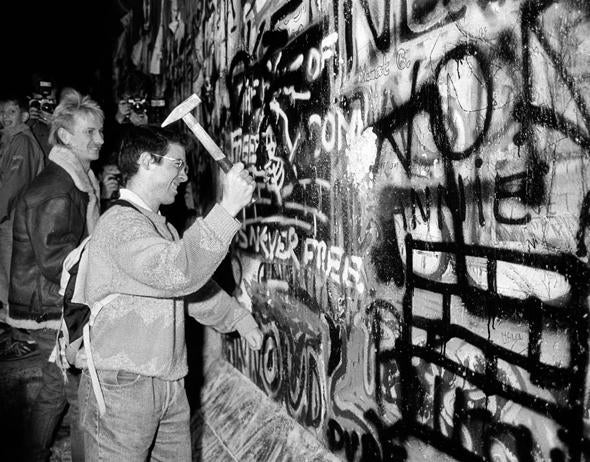On a Sunday afternoon 25 years ago, as a Boston Globe reporter, I strolled through the rubble of what had been the Berlin Wall, wondering how I might explain to a younger person, 25 years hence, that there ever was a 12-foot-high wall in this space dividing one of the world’s most vibrant cities and binding together one of the world’s most sclerotic empires.
And now here we are, about to commemorate the silver anniversary of Nov. 9, 1989, when the wall came crashing down, East and West Berliners drank and danced together in the streets—saw one another, anywhere, in any mood—for the first time in nearly three decades, and the Cold War era of international politics, which had held the world in a gruesome equilibrium for nearly half a century, began to unravel.*
To understand the end of that era requires a look back at its beginning. In 1945, as World War II came to a close, the Allied powers—the United States, Britain, France, and Russia—divided the spoils of Germany at roughly the spot where their armed forces met in victory. Germany itself was divided into two nations, the Communist East and the capitalist West. And the city of Berlin, 100 miles inside the new East Germany’s borders, was also split, with West Berlin trumpeted as a symbol—and a tangible fact—of freedom’s endurance.
In 1948–49, the Soviets mounted a nearly yearlong blockade of Berlin, but the U.S. Air Force broke it with a round-the-clock airlift of supplies. In 1959, Soviet Premier Nikita Khrushchev demanded that the West sign a treaty to end World War II, which would incorporate all of Berlin into East Germany, and threatened to take it forcefully if the West refused. Diplomacy eased that crisis, but Khrushchev renewed it in the spring of 1961, thinking he might bully the young new American president, John F. Kennedy, into submission. The crisis came to a head on Oct. 27, 1961, when Soviet and American tanks faced each other for 25 hours, at close range, across the last open checkpoint between West and East Berlin. The crisis was so heated that at one point the Pentagon drew up plans—which Kennedy seriously considered—to launch a nuclear first-strike against the Soviet Union if Khrushchev made good on his threat. (At the time, NATO had few conventional ground forces that could stave off an occupation.) Finally, again, the Soviets backed down.
It was during this crisis—on the night of July 13—that the border between East and West Berlin was sealed and the wall began to rise. Kennedy was one of the few who recognized, at the time, that the wall didn’t intensify the crisis but, rather, ended it. “Better a wall than a war,” he mused to his aides. There were no more Berlin crises after the wall went up.
But the key point, which many now forget, is why Khrushchev built the wall to begin with. His motive was to preserve the Soviet empire, which was far more fragile than any outsider knew. Beginning in the mid-1950s, East German citizens began to use the open city of Berlin as a portal for fleeing to the West. By 1961, 2 million of them—mostly young and highly educated—had fled in this manner, and the exodus continued at the rate of 10,000 each month.

Photo by Gerard Malie/AFP/Getty Images
Under pressure from Kremlin hardliners, Khrushchev erected the wall to preserve the East German state—which was the most prosperous and heavily armed of Russia’s frontline Warsaw Pact allies. It is dizzying to contemplate the mindset of the Soviet commissars in those times, at least those who weren’t entirely deluded by their own propaganda: The imposition of their power was so deeply resented—and their ideology was so out of whack—in the crown jewel of their empire that they had to build a wall to keep its most prized people from going over to the West. (And, as we later learned from the unshackled Stasi archives, they also had to compel half the remaining population to spy and inform on the other half.)
East Germany lay at the heart of the Soviet empire. The Berlin Wall was the cap that kept the volcano from erupting. So when the cap popped off, the lava exploded and flowed in mad directions. Once again, Berlin was the portal to escape.
Few things in life are inevitable, but it was very nearly inevitable that, soon after the wall fell, the larger border between East and West Germany would evaporate, Germany would reunify as one state (the western one, as the eastern one instantly crumbled), other Warsaw Pact states with a democratic history (notably Czechoslovakia and, to some extent, Poland) would resume their long-interrupted history, and the Soviet Union itself—already in the turmoil of Mikhail Gorbachev’s reforms—would implode.
The Russian Federation’s current president, Vladimir Putin, was a KGB officer in East Germany during its final days, and it’s been reported that even he—no nascent democrat—was appalled at the totalitarianism of its state apparatus. Yet the sudden implosion of his homeland’s empire, and the laying open of its borders to Western businessmen and TV shows, clearly left him traumatized. His current policies can be seen as a reaction to those embittering days.
The wall’s tumbling had repercussions far beyond its nearby politics. When the Soviet Union imploded, so did the Cold War system that had kept much of the world locked in a proxy East-West confrontation. And so, while the events of 25 years ago unleashed the pent-up yearnings for democracy and a free market in Berlin, Prague, Warsaw, and Moscow, they also unleashed the yearnings for sectarian autonomy or domination in much of the Middle East and South Asia.
If the Berlin Wall were still standing, which is to say if the Cold War were still raging, it is hard to imagine that there would have been, on the one hand, an Arab Spring or, on the other hand, a thriving al-Qaida. One superpower client or another would have nipped such movements in the bud, as often happened in the old days.
The collapse of the wall led to democracy for some and lawlessness or new forms of dictatorship for others. In other words, it shattered the amber in which history had, in many ways, been frozen for 44 years and freed the forces lying beneath—the sects, tribes, ideologies, and allegiances—to flow forth once more with unrestrained vigor, for better, worse, and both.
Correction, Nov. 17, 2014: This article originally misstated that the 25th anniversary of the fall of the Berlin Wall was the golden anniversary. (Return.)
